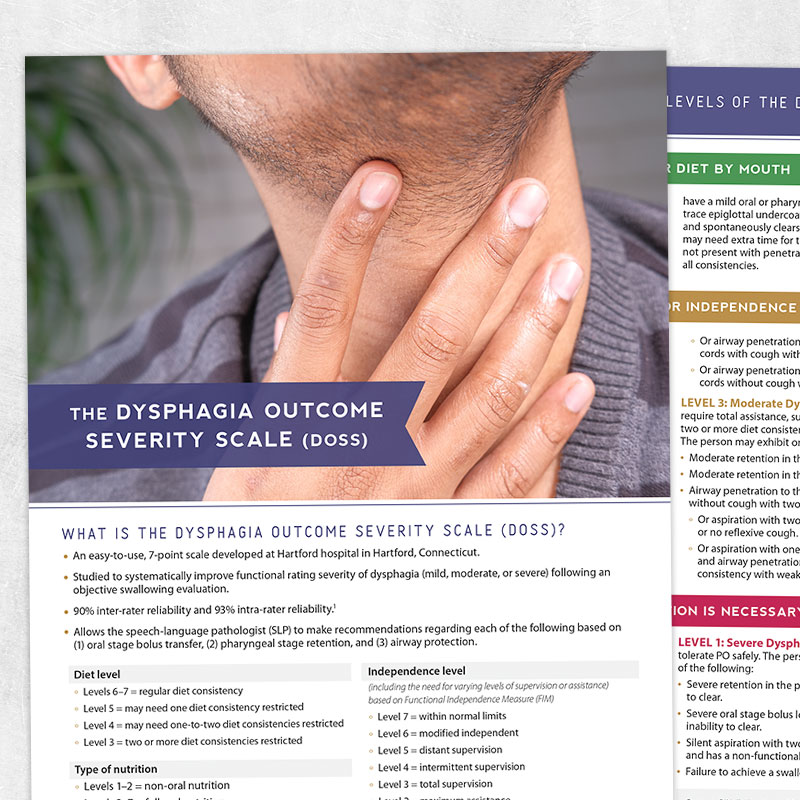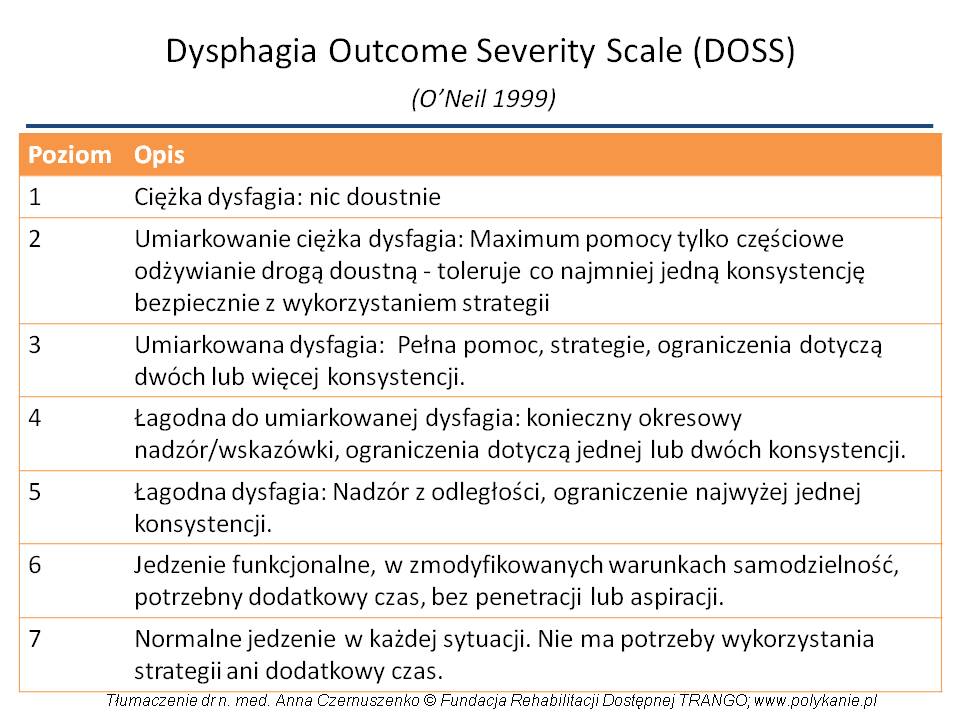Dysphagia Outcome And Severity Scale Printable
Dysphagia Outcome And Severity Scale Printable - Elderly patients (≥65 years) performing a swallowing evaluation were included and divided according to the dysphagia outcome and severity scale (doss). Web moderately severe dysphagia—patient aspirates 5% to 10% on one or more consistencies, with potential for aspiration on all consistencies. Web one way to achieve this is with patient reported outcome measures (proms) and severity scales. Unable to tolerate any p.o. Unable to tolerate any p.o. Safely may exhibit one or more of the following severe retention in pharynx, unable to clear severe oral stage bolus loss or retention, unable to clear silent aspiration with two or more consistencies, nonfunctional volitional cough or unable to achieve swallow 142 table 1. This resource provides information regarding the scale and how to determine which level accurately describes a person’s swallowing function. It grades how severe clinical dysphagia is, by quantifying how much modification is required to fluids and diet, as well as level of supervision, for safe oral intake. Maximum assistance or use of strategies with partial po only (tolerates at least one consistency safely with total use of strategies) This is an opportunity for us to implement research into our clinical practice. Unable to tolerate and po safely level 2: This is an opportunity for us to implement research into our clinical practice. The dysphagia severity rating scale (dsrs), which grades how severe dysphagia is based on fluid and diet modification and. Web post stroke dysphagia (psd) is common and associated with poor outcome. Web moderately severe dysphagia—patient aspirates 5% to 10%. The national foundation of swallowing disorders has provided an online version. Potential for aspiration minimized by specific swallow. Web you can consider a score of 3 or higher abnormal. Web oral mechanism form assessments for textures and liquids a few of the most common assessments for textures and liquids. This resource provides information regarding the scale and how to determine. Elderly patients (≥65 years) performing a swallowing evaluation were included and divided according to the dysphagia outcome and severity scale (doss). The dysphagia severity rating scale (dsrs), which grades how severe dysphagia is based on fluid and diet modification and. Web post stroke dysphagia (psd) is common and associated with poor outcome. Assigns an objective level of function for swallowing. The national foundation of swallowing disorders has provided an online version. Maximum assistance or use of strategies with partial po only (tolerates at least one consistency safely with total use of strategies) Safely severe retention in pharynx, unable to clear severe oral stage bolus loss or retention, unable to clear silent aspiration with two or more consistencies, nonfunctional volitional cough. Web the dysphagia outcome and severity scale. Potential for aspiration minimized by specific swallow. Web the dysphagia outcome severity scale (doss) is a scale studied and created at hartford hospital to systematically improve functional rating severity of dysphagia following an objective swallowing evaluation. Web the dsrs is a clinician rated scale that was developed from the dysphagia outcome and severity. Web the dysphagia outcome and severity scale. Unable to tolerate and po safely level 2: Web post stroke dysphagia (psd) is common and associated with poor outcome. Web moderately severe dysphagia—patient aspirates 5% to 10% on one or more consistencies, with potential for aspiration on all consistencies. Web you can consider a score of 3 or higher abnormal. Designed to improve consistency of documentation. Unable to tolerate and po safely level 2: Safely severe retention in pharynx, unable to clear severe oral stage bolus loss or retention, unable to clear silent aspiration with two or more consistencies, nonfunctional volitional cough or unable to achieve swallow The ndd further speculates that a severity outcome scale, such as the dysphagia. Web moderately severe dysphagia—patient aspirates 5% to 10% on one or more consistencies, with potential for aspiration on all consistencies. The national foundation of swallowing disorders has provided an online version. Assigns an objective level of function for swallowing based on multiple factors (mbs findings and functional oral intake). Anderson dysphagia index (mdadi) is a valid, reliable questionnaire for The. Web moderately severe dysphagia—patient aspirates 5% to 10% on one or more consistencies, with potential for aspiration on all consistencies. It grades how severe clinical dysphagia is, by quantifying how much modification is required to fluids and diet, as well as level of supervision, for safe oral intake. Web one way to achieve this is with patient reported outcome measures. This resource provides information regarding the scale and how to determine which level accurately describes a person’s swallowing function. Unable to tolerate and po safely level 2: Maximum assistance or use of strategies with partial po only (tolerates at least one consistency safely with total use of strategies) The ndd further speculates that a severity outcome scale, such as the. Potential for aspiration minimized by specific swallow. Web oral mechanism form assessments for textures and liquids a few of the most common assessments for textures and liquids. Assigns an objective level of function for swallowing based on multiple factors (mbs findings and functional oral intake). Maximum assistance or use of strategies with partial po only (tolerates at least one consistency safely with total use of strategies) Safely severe retention in pharynx, unable to clear severe oral stage bolus loss or retention, unable to clear silent aspiration with two or more consistencies, nonfunctional volitional cough or unable to achieve swallow Web post stroke dysphagia (psd) is common and associated with poor outcome. It grades how severe clinical dysphagia is, by quantifying how much modification is required to fluids and diet, as well as level of supervision, for safe oral intake. Web the dysphagia outcome and severity scale. This resource provides information regarding the scale and how to determine which level accurately describes a person’s swallowing function. This is an opportunity for us to implement research into our clinical practice. Unable to tolerate any p.o. The national foundation of swallowing disorders has provided an online version. Designed to improve consistency of documentation. Web moderately severe dysphagia—patient aspirates 5% to 10% on one or more consistencies, with potential for aspiration on all consistencies. Anderson dysphagia index (mdadi) is a valid, reliable questionnaire for The ndd further speculates that a severity outcome scale, such as the dysphagia outcome and severity scale (doss) may be useful to “describe a patient’s dysphagia sufficiently to begin the diet prescription process for that patient.”. Web one way to achieve this is with patient reported outcome measures (proms) and severity scales. Unable to tolerate and po safely level 2: Web you can consider a score of 3 or higher abnormal. Unable to tolerate any p.o. Web we would like to show you a description here but the site won’t allow us. Anderson dysphagia index (mdadi) is a valid, reliable questionnaire for The ndd further speculates that a severity outcome scale, such as the dysphagia outcome and severity scale (doss) may be useful to “describe a patient’s dysphagia sufficiently to begin the diet prescription process for that patient.”. Web the dysphagia outcome severity scale (doss) is a scale studied and created at hartford hospital to systematically improve functional rating severity of dysphagia following an objective swallowing evaluation. Unable to tolerate any p.o. Web the dysphagia outcome and severity scale. Web one way to achieve this is with patient reported outcome measures (proms) and severity scales. Safely severe retention in pharynx, unable to clear severe oral stage bolus loss or retention, unable to clear silent aspiration with two or more consistencies, nonfunctional volitional cough or unable to achieve swallow Elderly patients (≥65 years) performing a swallowing evaluation were included and divided according to the dysphagia outcome and severity scale (doss). Designed to improve consistency of documentation. This is an opportunity for us to implement research into our clinical practice. Web oral mechanism form assessments for textures and liquids a few of the most common assessments for textures and liquids. Safely may exhibit one or more of the following severe retention in pharynx, unable to clear severe oral stage bolus loss or retention, unable to clear silent aspiration with two or more consistencies, nonfunctional volitional cough or unable to achieve swallow 142 table 1. Web you can consider a score of 3 or higher abnormal. Assigns an objective level of function for swallowing based on multiple factors (mbs findings and functional oral intake). Unable to tolerate and po safely level 2:Dysphagia and Severity Scale Download Scientific Diagram
Table 1 from Accuracy of Dysphagia Severity Scale rating without using
The Dysphagia Severity Scale (DOSS) Therapy Insights
Teaching in General Teaching Methods Journal Pdf
Fiberoptic Endoscopic Dysphagia Severity Scale (FEDSS) Download Table
The Dysphagia Severity Scale (DOSS) Therapy Insights
The Dysphagia Severity Scale (DOSS) Printable handouts for
Funkcjonalne skale nasilenia dysfagii
Dysphagia and Severity Scale (DOSS). Download Scientific Diagram
Severity score of dysphagia for every swallow Download Table
The Dysphagia Severity Rating Scale (Dsrs), Which Grades How Severe Dysphagia Is Based On Fluid And Diet Modification And.
Maximum Assistance Or Use Of Strategies With Partial Po Only (Tolerates At Least One Consistency Safely With Total Use Of Strategies)
Web Post Stroke Dysphagia (Psd) Is Common And Associated With Poor Outcome.
Unable To Tolerate Any P.o.
Related Post:










